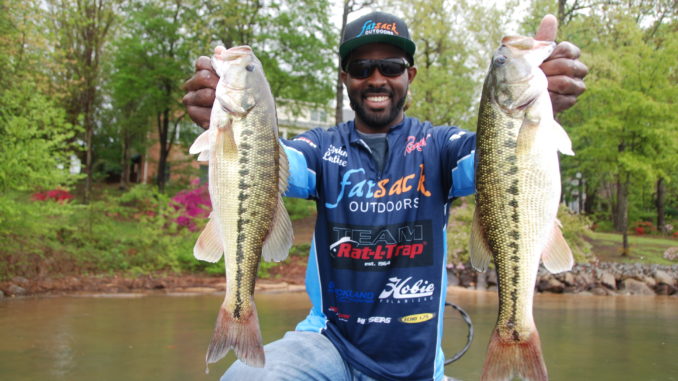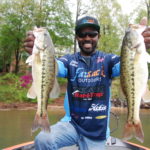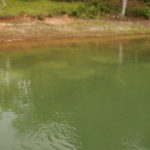
Target Keowee’s spots, largemouths with different tactics as the spawn approaches.
Lake Keowee. The name brings joy to the heart of some anglers and tears to the eyes of others. For bass fishermen, it can be a mix of both — on the same day, maybe even just an hour or even a few casts apart.
The reason that Lake Keowee is so perplexing to a number of anglers is because the lake is extremely deep, extremely clear, and for the most part, devoid of traditional bass-fishing cover. Also, Keowee was once a burgeoning fishery for largemouth bass, at least as much as a deep clear, infertile lake can be, and then the spotted bass took over.
Today, largemouths are making something of a comeback at Keowee. Many tournament fishermen aim to catch a decent limit of spotted bass, then spend time trying to catch a big largemouth to give them a winning weight. Some of them succeed.
Bass pro Brian Latimer of Anderson said that Keowee fishes like to different lakes, depending on whether you are targeting largemouths or the more dominant spots.
“If I wanted to catch largemouth this time of year, I’d probably run to the backs of pockets and throw jigs around docks, swimbaits, things like that,” Latimer said. “Even A-rigs, umbrella rigs, are a really good way to target largemouth, especially if you’ve got cloudy, rainy weather in the spring.”
In late March, Latimer said he’ll fish for spots the same way he has through the winter, as they are prone to roam the expansive, open waters of the lake. He said it’s not until the urge to spawn literally pushes them into the shallows that he will change up.
“It’s kind of weird,” Latimer said. “The pattern stays the same in March as it does in January and February, so you can still catch them 30 foot to 40 foot deep. Spotted bass don’t really have a big push shallow until it’s almost time for them to spawn.”
Latimer said spotted bass frequent such a wide variety of depths and will hit such a wide variety of baits that it’s hard to pick one or two baits and a particular depth range to target. He prefers to hedge his bet by keeping his boat along the bank, because at Keowee, that puts him in prime, average-depth waters.
“To concentrate and simplify my day, I’ll usually just stay in that mid-range depth, nothing over 15 foot, which means I still beat the bank,” he said. “Even after the last of March, when I can almost guarantee they’re going to be spawning, it’s not unusual for a spot to make a bed in 10 foot of water.”
“Another thing is that spotted bass in Keowee spawn way before largemouth are even thinking about (it), and they spawn way after largemouth are done spawning,” he said. “Spots continue spawning way longer because they’re main-lake oriented fish.”
Latimer said traditional bed fishing for spots is not the same as it is for largemouths. Because of the water depth, rather than seeing actual fish, he’s on the lookout for dark-colored patches on the lake floor. He doesn’t worry about putting his bait on the nose of the fish, because the more-aggressive spots will come off the area to hit a bait that has invaded it’s territory.
“You can catch them just casting to dark spots on main-lake points and islands,” said Latimer. “If you see a little dark spot way off, you can just cast to it, and the spots will come and get it.”
Latimer’s bait choices at Keowee are fairly standard for a clear lake. He’s going to target fish feeding at or just below the surface in low-light conditions, then concentrate on fish holding closer to structure and closer to the bottom when the sun’s out.
“I’ll start off with like a hard or soft jerkbait, maybe a Zoom Super Fluke or something like that, first thing in the morning,” he said. “As the day progresses, the sun gets over the trees, it just really becomes simple. I’d have a green pumpkin jighead on, probably a wacky rig and some type of stickbait or single style bait.”
Latimer targets main-lake areas, concentrating on main-lake structure, main-lake points, main-lake islands, short main-lake coves and pockets. Keowee has such an abundance of spotted bass that the fish don’t have any choice except to spread out over the lake, but even with such distribution, Latimer still has particular areas he prefers because of the habitat.
“I spend probably 90 percent of my time in the South Cove area, around the islands in South Cove; there is so much structure, you could fish for a week and not cover it all,” he said. “Fish tend to move up first on the Hot Hole section of the lake, from Mile Creek to Stamp Creek, but I believe the fish are larger and there’s better cover at South Cove, so I’ve always concentrated there.”
One of Latimer’s fishing buddies, Nick Rubio of Greer, fished his first-ever bass tournament on Keowee his freshman year at Clemson; he was on the school’s first bass-fishing team.
“I never got a bite, I never caught a fish, and I think I came in last place in that tournament,” said Rubio, who went on to found Fatsack Outdoors. “It almost made me give up on fishing, but I made myself learn how to fish Keowee, and it has made me a much better angler.”
Rubio said Keowee changes a lot in topography after falling out of Lake Jocassee, where the banks are steep and mountainous, to the south end of the lake, which looks more like Lake Hartwell farther downstream.
“I also prefer the South Cove area, not just for spotted bass, but for largemouth as well,” Rubio said. “The creeks are flatter, and there is some sparse grass around the docks which are in more shallow water, as well.”
His favorite largemouth baits for Keowee include Skinny Dippers, soft-plastic baits made by Reaction Innovations, and Yum Money Minnows. He casts them to cuts and pockets around boat docks where largemouth are lurking, particularly in the spring when the bigger females come in to bed.
Rubio credits Keowee with forcing him to record details of every trip in a log and using the data collected over multiple trips to interpret patterns that he otherwise may not have noticed.
“After my first experience at Keowee, I started keeping a log of my trips. My information base and my knowledge grew from there,” said Rubio. “That learning practice eventually led me to develop the Fatsack fishing log app.”
DESTINATION INFORMATION
HOW TO GET THERE — Lake Keowee’s shorelines are home to ample public boat ramps. On the Oconee County side, Stamp Creek Landing is northeast of Walhalla at the end of County Road 92, just off SC 183. The Cane Creek ramp is north of Seneca just off SC 188. In Pickens County access to Crowe Creek is west of Pickens off SC 133 at the intersection of County Road 172. Additional public launches can be found at www.duke-energy.com/lakes/facts-and-maps/lakekeowee.
BEST TECHNIQUES — Spotted bass can be anywhere from 8 to 40 feet deep in late March and early April. Depths of around 15 feet on the south end of the lake are likely the most productive. Fish hard or soft jerkbaits in low-light conditions. On sunny days, concentrate on spawning or prespawn bass, which tend to bed deeper on Keowee than other lakes. Look for “dark spots” on long, main-lake points, humps or islands. Spotted bass are not as finicky about presentations as are largemouths. Try casting soft-plastic jerkbaits into pockets and cuts around shallow docks for largemouths.
FISHING INFO/GUIDES — Brad Fowler, 864-934-5813, www.fowlerfishing.com; Lake Keowee Marina, Seneca, 864-882-2047. See also Guides and Charters in Classifieds.
ACCOMMODATIONS — Mountain Lakes Convention and Visitors Bureau, 877-MTLAKES, www.scmountainlakes.com.
MAPS — Kingfisher Maps, 800-326-0257, www.kfmaps.com; DeLorme’s South Carolina Atlas and Gazetteer, 800-561-5105, www.delorme.com.




Be the first to comment